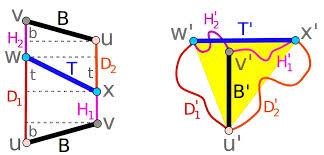Richard Schwartz, a mathematician at Brown University has found a solution to the problem of how small a Möbius band can be made without intersecting itself—at least for a smooth piece of paper. The paper is published on the arXiv preprint server.
A Möbius strip (or band) is both a physical and mathematical object. A sample can be constructed by twisting a simple strip of paper one time and then taping the ends together. Since they were first discovered back in the mid-1800s, mathematicians have been scratching their heads trying to determine one simple constraint—what is the shortest strip necessary for making one? Back in the late 1970s, a pair of mathematicians, Charles Sidney Weaver and Benjamin Rigler Halpern, found that the problem could be made simpler by allowing self-intersections—that changed the problem to one that involved seeking the minimum amount of strip needed to avoid self-intersections.
Four years ago, Schwartz found himself intrigued by the problem and, as he describes in his paper, became “hooked” on finding a solution. Two years ago, he thought he had finally found it and published a proof showing his work—it involved breaking down the problem into multiple pieces and then using geometry principles to solve the puzzle as a whole.
Unfortunately, there turned out to be a major flaw in his work that he did not discover until much more recently. He found it by creating physical samples and cutting them in different ways to see how they worked on a deeper level. He discovered that the 2D strip was not shaped like a parallelogram as had been thought—instead, it was a trapezoid.
Inspired by his discovery, he went back to this original proof and corrected the error, and in doing so, found that the proof worked much better than it had originally. It was also much simpler. He also used the proof to work out the optimization problem, and got what he was hoping for: √3. He notes that while pleased with his own work, he has already turned his attention to another problem—to determine how short a band can be if it is twisted three times instead of once.\
For more such insights, log into our website https://international-maths-challenge.com
Credit of the article given to Bob Yirka, Phys.org


